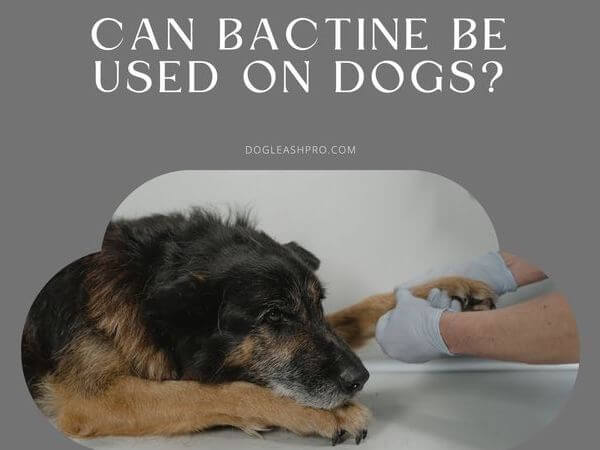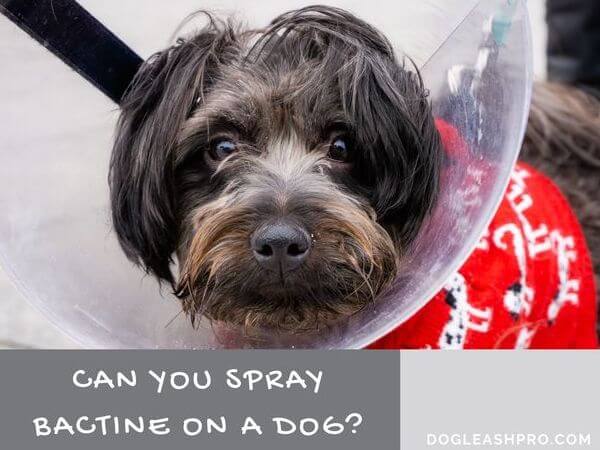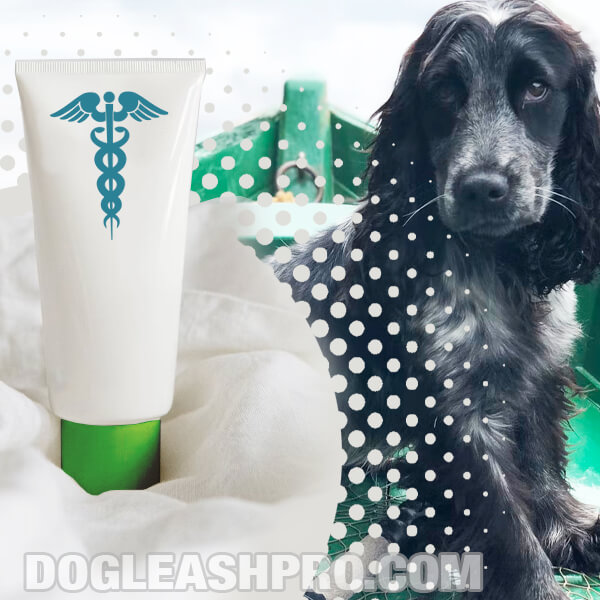
While it’s rare for our furry companions to get minor scrapes or cuts while playing at the dog park or in your backyard, it can happen. While at the dog park, my dog likes to claw at the chain link fence to greet other dogs. Five minutes in, I noticed there was blood dripping from his paw. Having Bactine at home, I immediately wondered, “Can I use Bactine on my dog?” Here’s the short answer first.
Can you use Bactine on dogs? Yes, you can safely use Bactine on your dog’s cuts, hot spots (or canine dermatitis), scratches, and minor scrapes. These types of minor wounds can typically be treated at home with Bactine spray, which is a safer option than using other over-the-counter antibiotic ointments. However, for your dog’s safety, there are a few things to be aware of when applying Bactine on your canine friends.
In this article, we’ll discuss how to keep your canine companions safe when you’re using Bactine on dogs and whether this product is dog-friendly or if we should use other products like baby wipes to clean our dog’s wound.
Table of Contents
Can you use Bactine On Dogs?

It’s common for many of us to have a bottle or two of Bactine spray at home. We may keep it in our medicine cabinet or in our kitchen drawer.
When our canine friends incur a minor cut or scrape while rough playing with other dogs or while playing in the backyard, we want to immediately help them by reaching for that bottle of Bactine spray.
But is that a smart decision? Can you use Bactine on a dog? Before we answer this question, let’s briefly go over what Bactine is and the ingredients in this spray and see whether it is safe to use on our furry friends.
What is Bactine?
Bactine is a topical antiseptic with anesthetic abilities. The Bactine® MAX Pain Relieving Cleansing Spray and Liquid contains two main active ingredients:
- Benzalkonium Chloride (BAC) 0.13% w/w (weight per weight): A powerful antiseptic that helps to prevent skin infections from minor cuts and wounds by getting rid of bad bacteria.
- Lidocaine HCL 4.0% w/w (weight per weight): An effective topical anesthetic that provides temporary relief from itching and pain on the dog’s skin.
Let’s discuss these two ingredients in greater detail next.
What is in Bactine and how does it help my dog?

You’ll often find BAC in common household cleaning products like Lysol, Purell, and Scrubbing Bubbles. You can also find BAC in antibacterial disinfectants like Clorox. In addition to getting rid of bad bacteria, BAC is perfect to use on any minor injuries your K9 friends incur.
That’s because it’s long-lasting, gets absorbed into the skin quickly, and heals the upper epidermis layer of the dog’s skin. Remember, just a tiny amount should do the trick. Try not to spray too much Bactine on your pooch.
The other active ingredient in Bactine is lidocaine. As mentioned above, it works hand in hand with BAC by relieving any itching or pain your pooch may experience from his wound and distracting him so he doesn’t lick or bite the wounded skin.
Lidocaine works by numbing the specific wounded area and preventing any itching or pain. Lidocaine in Bactine works like magic because it blocks the movement of sodium ions in cells and this prevents any communication, which stops the nerve activity.
The combination of these two active ingredients helps with the following all at the same time:
- Cleanses and disinfects the wound.
- Heals the wound.
- Prevent pain and itching by numbing the wounded site.
So, can you put Bactine on dogs, and is it safe for dogs? Let’s find out next.
Is Bactine safe for dogs?
As dog owners, we should always err on the side of caution when using or applying products formulated for human use on our four-legged friends. Some human products are simply not safe for our dogs and pets.
So is Bactine one of them? Is Bactine Max safe for dogs?
Yes, Bactine or Bactine Max is safe to use on dogs as a first-aid option if there’s no other dog-friendly antiseptic or topical anesthetic treatment at home to disinfect the wound and provide temporary relief.
In addition to using it on minor cuts, scrapes, and scratches, Bactine is also perfect for the following:
- Yeast infections.
- Hot spots (canine dermatitis).
- Skin rashes.
- Staph infections.
- Poison ivy.
- Worn paw pads.
- Insect bites.
While Bactine is safe to use on dogs, we’d still highly recommend that you consult with your dog’s veterinarian to confirm that you can use this product that’s formulated for humans on your furbabies.
That’s because your vet can give you advice and suggestions on the following:
- How much of the Bactine you can use on your pooch.
- How often you can use this product on your K9 pal.
- When it is or is not appropriate to use Bactine on your dog.
This information is crucial because it keeps your furry friends safe while you use Bactine on them. If you accidentally apply a lot of Bactine on your dog’s skin, there can be serious consequences.
That’s because applying too much Bactine means there may be high levels of Lidocaine HCL that can get absorbed through the skin and into the dog’s body and this can be dangerous or even lethal to dogs.
As we can see, it’s always best to speak with your dog’s vet before using any over-the-counter antiseptic, anesthetic, or other antibiotic ointments on our canine friends.
Bactine for dogs: Possible risks

Bactine for dogs is a good idea if there are no other dog-friendly antiseptic or topical anesthetic treatments around at home.
By applying or using the right amount of Bactine on your dog’s wound, it can help to disinfect and clean the wound, remove bad bacteria to prevent infections, and provide temporary relief, especially from pain or itching.
Many times, our dogs have a natural tendency to lick, nip, or bite at their wound because it is itching or painful. Doing so could actually worsen the wounded area because your dog’s mouth carries tons of bacteria. The bacteria can then cause a skin infection.
By using Bactine, it can help to provide some temporary relief by numbing the wounded area. This way, your dog doesn’t notice that the wound is there and it allows the wounds to heal much more quickly and nicely.
However, when you’re applying Bactine on your dog, make sure you have either a cone of shame or a light dressing available and on hand. Believe us, your dog may have to wear it.
That’s because our K9 friends are naturally curious and they will try to sniff and lick the Bactine when you’re using it on them.
You may also like: Why Is My Dog Licking The Floor?
Since Bactine contains topical anesthetic lidocaine and antiseptic benzalkonium chloride (as mentioned above), the combination of these two ingredients can cause an initial sting sensation when it’s first sprayed on your dog’s wounded skin.
This stinging sensation can be uncomfortable and can cause your dogs to have a wild fit such that they may start barking, growling, biting, yelping, or even squirming.
RELATED: Do Dogs Get Tired Of Barking?
If you notice your curious pooch trying to lick the wounded area where you’ve sprayed the Bactine, you’ll want to use a cone of shame or cover the area with a light cloth. This will prevent your dog from licking the chemicals found in the Bactine.
While Bactine is safe when you apply it externally on your dog’s skin, it’s not safe when your dog tries to lick it. That’s because both the ingredients benzalkonium chloride and lidocaine can cause minor toxicity when ingested and you can expect a high concentration of Bactine in your pup’s mouth.
Signs and symptoms of ingesting Bactine include:
- Mouth and Tongue ulcerations. The two active ingredients mentioned above can damage the soft tissue lining in your dog’s inner cheeks, tongue, palate, lips, and gums. This type of damage can cause sores to develop in the mouth and tongue.
- Drooling excessively or drooling more than before.
- Tremors.
- Diarrhea.
- Vomiting.
- Loss of appetite.
- Fever.
- Loss of muscle function or weakness in the muscle.
If you suspect your dog has licked the Bactine you’ve just sprayed on the wounded area or found out that your pooch has some form of oral ulceration, you’ll want to contact your vet immediately. This requires immediate medical attention and the sooner it is treated, the better.
Your vet may ask you to bring your pooch in for a physical examination and a check-up. If the oral ulceration is severe, the vet may ask that your pooch stays overnight at the hospital. He or she may administer IV fluids and even a feeding tube so that your dog can stay full without using his mouth. This allows your dog’s mouth to heal nicely and properly.
If the oral ulceration is mild, then the vet may simply administer pain-reliever.
Fortunately, the Bactine topical spray is not toxic to dogs and it also has a bitter taste which will discourage your four-legged friends from licking it again.
Can you spray Bactine on dogs?
As we can see, you can certainly spray Bactine on dogs, but here’s the catch. If you’re wondering, “Can I spray Bactine on my dog?” here’s what you need to know and be aware of.
Bactine is most effective on minor scrapes and cuts that your dog sustains from rough play with other pets in the house, other dogs in the dog park, or from minor grooming accidents.
Handy Hint: To prevent minor grooming accidents like accidentally cutting into the quick while trimming your dog’s nails, try using a dog nail grinder. In our Best Dog Nail Grinders (Reviews & Top Picks Guide), we’ve provided a list of precise and whisper-quiet nail grinders you’ll want to get for your precious pooch.
Bactine is not suitable or effective on deep cuts or tears in the dog’s skin (large lacerations) or deep puncture wounds. If your precious pooch has sustained any one of these, you’ll want to put the Bactine down and instead call your vet as soon as you can. This type of deep cut or tear requires immediate professional and medical attention.
Can you use Bactine spray on dogs with hot spots?
Hot spots or canine dermatitis are extremely painful to dogs. They’re an irritating skin condition that can cause itching. When dogs have hot spots, it can be a traumatic self-perpetuating cycle of scratching and itching and this can lead to skin inflammation and bacterial infections.
Fortunately, as listed above, you can use Bactine spray on dogs with hot spots.
According to VCA Animal Hospital, there are two types of canine hot spots:
- Acute moist dermatitis.
- Pyotraumatic dermatitis.
If you see some painfully-looking red lesions on your dog’s skin, chances are that they are hot spots. The affected skin is bloody red and inflamed. When dogs continue to scratch or bite at the hot spot caused by the itching, it only makes the hot spots worse.
Dogs may aggressively scratch their itchy skin and this can cause their skin to tear more and become more exposed. Continuous biting, scratching, or licking will only prevent the hot spots from healing properly.
Not only will there be blood, but pus and ooze as well. Hot spots are commonly found on your dog’s hips, legs, and head because these are the areas where your dog can easily reach, scratch, and bite.
If you notice that your pooch has hot spots, we highly recommend that you consult your dog’s vet as soon as possible. It’s important to know what’s causing the hot spots and treating them early can prevent potential bacterial infections.
Your vet will know which medication is best for your pooch and this will ensure that the hot spot will heal nicely.
Meanwhile, you can use Bactine spray on your dog to ease the pain and itching caused by the hot spots.
The Benzalkonium Chloride (BAC)’s antiseptic properties in Bactine will help to clean, disinfect, and sterilize the hot spots so that the skin can start to heal.
The Lidocaine’s anesthetic properties in Bactine will help to numb the pain and provide temporary relief so that your pooch doesn’t notice that the hot spots are there and doesn’t scratch or bite it anymore.
If you don’t have Bactine, there are other medications that may work as well on your dog’s hot spots such as Prednisone (oral steroids) or Benadryl (antihistamines).
Before you apply these other medications to your K9 friends, we highly recommend that you consult your dog’s vet first.
In some cases, your pooch may be allergic to one of the above forms of medication and this can be avoided simply by speaking with your vet before administering it to your pup.
Lastly, wearing either a cone of shame or an E-collar is necessary when treating hot spots in dogs.
When dogs wear either a cone of shame or an E-collar, they’re not able to lick or bite at the hot spot. Additionally, wearing one can also prevent them from licking the hot spot that’s probably covered in ointment or spray you’ve just applied.
Ingesting the ointment or chemicals from the spray can lead to other health issues.
Bactine vs Neosporin
The main difference between Bactine and Neosporin is that Bactine is both an anesthetic and an antiseptic while Neosporin is simply an antibiotic.
This means that Bactine can help to prevent the feeling of pain or itchiness while also helping to clean the dog’s skin. Bactine can help to slow down the growth of bad bacteria on the skin by getting rid of the bad bacteria.
Neosporin, Polysporin, and Bacitracin, on the other hand, act more like an antibiotic which means they can help to prevent infection, but they won’t help with itching, pain, or any existing infections.
DISCLAIMER: THIS WEBSITE DOES NOT PROVIDE MEDICAL ADVICE
The information, including but not limited to, text, graphics, images and other material contained on this website are for informational purposes only. No material on this site is intended to be a substitute for professional veterinary advice, diagnosis, or treatment. Always seek the advice of your veterinarian or other qualified health care provider with any questions you may have regarding a medical condition.
BACTINE is a registered trademark of WELLSPRING PHARMACEUTICAL CORPORATION. Dogleashpro does not claim any ownership of the BACTINE name, logo, or any identifying mark in any way. This article is for educational purposes only.
Resources:
https://en.wikipedia.org/wiki/Benzalkonium_chloride/lidocaine
https://www.aspcapetinsurance.com/resources/deadly-consequences-pets-and-human-medication/

With over five years of specialized experience as an animal writer, my expertise lies in dog nutrition, health, behavior, grooming, and training. I am dedicated to delivering helpful and informative content that caters to the well-being of our furry friends. My primary goal is to empower pet owners with knowledge and ensure our canine companions thrive in health and happiness. In my free time, I love volunteering at local dog rescue centers.







